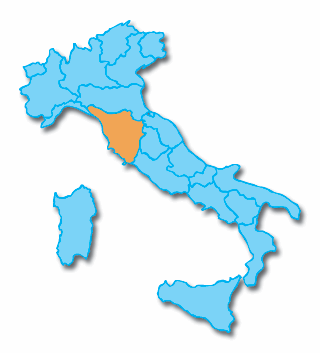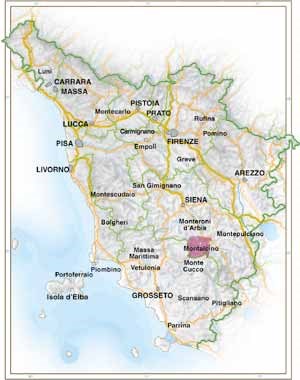BRUNELLO DI MONTALCINO DOCG
Producing area and denominations
Montalcino is a small hilly village in Siena province, south west of Tuscany. so small that only 5000 people live there. Montalcino hills stand like an Island in the heart of Tuscany, in a area which is far from main communications roads. The pure air together with the weather and soil make Montalcino a perfect place to grow grapes for wonderful red wines.
.

TUSCANY
.

.
A grape called Brunello was cultivated in Montalcino since the 14th century. But the Brunello wine we know now is about was born 150 years ago, when Clemente Santi and his grandson Ferruccio Biondi–Santi made experiments on Sangiovese grape in 19th century. Since those years, the name of Brunello di Montalcino started to be known like an Italian Top wine, together with Barolo and Barbaresco from Piedmont.
Brunello received the DOC status denomination in 1967, and in 1st of July 1980 Brunello was the first wine that received the DOCG mark, the highest status in Italy.
Brunello di Montalcino is produced with Sangiovese. In particular, a type of Sangiovese called Sangiovese Grosso (big Sangiovese). Since ancient time, this kind of grape was called Brunello (which means swarthy, dark), by Montalcino people.
After the second world war there was only 1 producer of Brunello di Montalcino (Biondi-Santi). Now More than 200 wineries and farmers joined the consortium of Brunello di Montalcino which is responsible to control the production of 4 wines: Brunello di Montalcino, Rosso di Montalcino, Moscadello di Montalcino e Sant’Antimo
brunello Production
The rules established by this consortium for Brunello di Montalcino are as follows:
- Production area: The Montalcino Township
- Variety: 100% Sangiovese (also called “Brunello” in Montalcino)
- Maximum yield of grapes: 80 quintals per hectare
- Ratio of grape yield to wine: 68%
- Minimum aging in wood: 2 years in oak. Minimum aging in bottles: 4 months
(6 months for the Riserva)
- Minimum alcohol content: 12.5% Vol.
- Minimum total acidity: 5 g/lt
- Bottling: can only be done with the production area
- Ready to be sold: 5 years after the year of the harvest (6 years for the Riserva)
- Packaging: Brunello di Montalcino can only be sold if it is in Bordelaise
shaped bottles
The consortium control is really severe, in order to keep the name and the quality of Brunello at top quality. A Winemakers who intentionally stray from these regulations can receive a conviction of commercial fraud and can go in jail for six years.
tasting Brunello
Brunello di Montalcino is a visibly limpid, brilliant wine, with a bright garnet colour. It has an intense perfume, persistent. One can recognize scents of undergrowth, aromatic wood, berries, light vanilla and jam.
To the taste the wine has an elegant harmonious body, vigorous and racy, it is dry with a lengthy aromatic persistence.
The elegance and the harmonious body of this wine allow for accompaniments of well structured and composite dishes such as red meats, game – both feather and fur, possibly accompanied by mushrooms and truffles. It also goes perfectly together with international cuisine dishes with a base of meats and sauces.
It’s also an excellent accompaniment for seasoned and structured cheeses. Moreover, because of its characteristics, it can be enjoyed alone, as a meditation wine.
Brunello di Montalcino should be served in ample shaped rounded glasses, so as to gather its composite harmonious bouquet. It should be served at a temperature of 18°C-20°C. The very old bottles should be decanted into a jug, in order to oxygenate them better and offer the wine in its total purity.
Because of its characteristics Brunello can be aged for a long time, improving as the years go by. It is not easy to determine exactly for how many years it improves. It depends on the vintage. It varies from a minimum of 10 years to around 30 years, but it can be kept for even longer.




